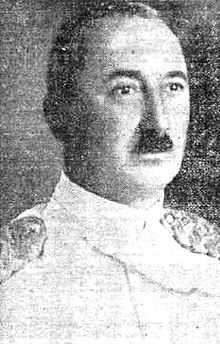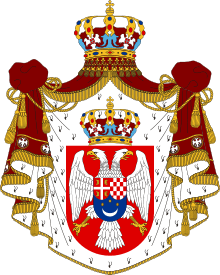Yugoslav government-in-exile

The Yugoslav government-in-exile was the official government of Yugoslavia, headed by King Peter II, which evacuated from Belgrade in April 1941, after the Axis invasion of the country, first to Greece, then Palestine, then to Egypt and finally, in June 1941, to the United Kingdom.
History
Fearing an invasion by the Axis Powers, Regent Prince Paul signed the Tripartite Pact on 25 March 1941, pledging cooperation with the Axis. Massive anti-Axis demonstrations followed in Belgrade.
On 27 March, the regime of Prince Paul was overthrown by a military coup d'état with British support. The 17-year-old Peter II was declared to be of age and placed in power. General Dušan Simović became his Prime Minister. The Kingdom of Yugoslavia withdrew its support for the Axis de facto without formally renouncing the Tripartite Pact. Although the new rulers opposed Nazi Germany, they also feared that if German dictator Adolf Hitler attacked Yugoslavia, the United Kingdom was not in any real position to help. Regardless of this, on 6 April 1941, the German armed forces (Wehrmacht) launched the invasion of the Kingdom of Yugoslavia and quickly conquered it. The royal family, including Prince Paul, escaped abroad and were interned by the British in Kenya.[1]
The Kingdom of Yugoslavia was soon divided by the Axis into several entities. Germany, Italy, Hungary, and Bulgaria annexed some border areas outright. A Greater Germany was expanded to include most of Slovenia. Italy added the Governorship of Dalmatia and more than a third of western Slovenia to the Italian Empire. An expanded Croatia was recognized by the Axis as the Independent State of Croatia (Nezavisna Država Hrvatska, NDH). On paper, the NDH was a kingdom and the 4th Duke of Aosta was crowned as King Tomislav II of Croatia. The rump Serbian territory became a military administration of Germany run by military governors and a Serb civil government led by Milan Nedić. Nedić attempted to gain German recognition of Serbia as a successor state to Yugoslavia and claimed King Peter II as Serbia's monarch. Puppet states were also set up in Montenegro and southern Yugoslavia. Hungary occupied several northern regions.
King Peter II, who had escaped into exile, was still recognized as King of the whole state of Yugoslavia by the Allies. From 13 May 1941, the largely Serbian "Yugoslav Army of the Fatherland" (Jugoslovenska vojska u otadžbini, or JVUO, or Četniks) resisted the Axis occupation of Yugoslavia. This anti-German and anti-communist resistance movement was commanded by Royalist General Draža Mihailović. For a long time, the Četniks were supported by the British, the United States, and the Yugoslavian royal government in exile of King Peter II.
However, over the course of the war, effective power changed to the hands of Josip Broz Tito's Communist Partisans. In 1943, Tito proclaimed the creation of the Democratic Federative Yugoslavia (Demokratska federativna Jugoslavija). The Allies gradually recognized Tito's forces as the stronger opposition forces to the German occupation. They began to send most of their aid to Tito's Partisans, rather than to the Royalist Četniks. On 16 June 1944, the Tito–Šubašić agreement was signed which merged the de facto and the de jure government of Yugoslavia.
During the exile King Peter II was educated at Cambridge University, served in the Royal Air Force and married Princess Alexandra of Greece and Denmark who was the only child of the late King Alexander I of Greece and Princess Aspasia of Greece and Denmark.
Armed forces
In exile, the Royal Yugoslav Forces were initially under the General Bogoljub Ilić as Minister of the Army, Navy and Air Force and Chief of the General Staff and General Borivoje Mirković as commander of the Air Force. There were initially about 1,000 men of these forces in exile at Cairo. On 12 January 1942 the king dismissed the prime minister, Ilić and Mirković, provoking a mutiny by officers supportive of the air force general.[2] The king then appointed Colonel Dragoljub Mihailović, leader of the Chetniks in Yugoslavia, as Minister and Chief of Staff to replace Ilić in absentia; he then appointed General Petar Živković to act as Mihailović's deputy in London and Cairo.[2] Mihailović was dismissed in August 1944 as Allied support shifted away from the Chetniks. On 7 March 1945 the king dissolved the government and disbanded the armed forces, proclaiming the Partisans on the ground to be the sole legitimate government and military.[2]
The first unit of the Royal Yugoslav Army to be formed in exile was the 1st Battalion, Royal Yugoslav Guards under Major Živan Knežević. It comprised a headquarters and four rifle companies (A, B, C and D). Of its original complement of 505 men, 411 were Slovenes who had been conscripted into the Royal Italian Army and subsequently captured by the British.[2] In January 1942 command of this unit passed to Lieutenant Colonel (Lt Col.) Miloje Dinić, and on 19 February to Lt Col. Milan Prosen, after Dinić was implicated in the pro-Mirković mutiny. (He and 57 other Guards were interned by the British at Torah camp in March, along with all 346 of the Yugoslav Air Force's ground personnel.)[3] In late February it was ordered to relieve the Czechoslovak contingent at the siege of Tobruk, but was diverted to join the 11th Brigade, 4th (Indian) Division in Libya. In April it retreated to Halfaya Pass and then to Mersa Matruh. In July, it was re-assigned to the 9th (British) Army in Mandatory Palestine to guard the oil refinery at Haifa.[2] In January 1943, when Lt Col. Franc Stropnik assumed command, the battalion was 850-strong and well-trained. It was attached to the 25th Brigade, 10th (Indian) Division. Before the end of the year monarchist and communist (pro-Tito) factions had appeared in the ranks; numbers dwindled. Barely the size of a company, a rump unit was sent to the Italian theatre with its brigade in March 1944.[3] It was soon after disbanded, despite the recruitment of 2,000 captured Slovene conscripts assembled in Algiers by Prosen. These men the British refused to ferry to Cairo, and so they were assigned labour duties.[3]
After the fall of Yugoslavia, 105 personnel of the Royal Yugoslav Navy, under Commander Z. V. Adamić, joined the Mediterranean Fleet at Alexandria in Egypt.[3] Two motor torpedo boats (MTBs), Durmitor and Kajmakčalan, and a submarine, Nebojša, ran the gauntlet of the Adriatic, evading the Italian Navy, and arriving in Suda Bay on 22–23 April, before proceeding to Alexandria.[4] The MTBs participated in the Syria and Lebanon campaign, while Nebojša undertook training exercises.[3] Ten floatplanes of the Naval Air Force also escaped. On 3 June 1941, the eight Dornier Do 22kj and two Rogožarski SIM-XIV-H formed the 2 (Yugoslav) Squadron of the No. 230 Squadron RAF based out of Aboukir. They participated in the Battle of Crete and patrolled the African coast until the unit was disbanded on 23 April 1942.[3] In late 1943, Commander J. Saksida was given command of a torpedo boat flotilla based at Malta, which included some former Yugoslav MTBs that had been captured by Italy in 1941 and then surrendered to the Allies after Italy's armistice, as well as three minelayers: Melinje, Miljet and Villa. The Yugoslav Navy was also operating eight former American PT boats and, after 11 January 1944, the ex-HMS Mallow (renamed Nada), out of Livorno in Italy. In March 1945 all Royal Yugoslav vessels assembled at Ancona in preparation for the handover to Tito's forces, which occurred in August.[3] The negotiations for the transfer of the vessels under British command took place on Vis. The royal representative was Captain Ivan Kern, whom Tito later promoted to rear admiral.
The eleven aircraft of the Royal Yugoslav Air Force to make it to Alexandria were requisitioned by the British. On 2 July 1942, the interned air force personnel and Guards were formed into the 244 Temporary Battalion of the King's Own Royal Regiment; but after a pro-Tito mutiny in November 1943 the unit was disbanded. Its personnel were transferred to the diminished Royal Guards, while 224 of the air force men joined the Balkan Air Force in Libya.[3] Joined by Partisan volunteers, these men formed No. 352 Squadron RAF on 22 April 1944, and on 1 July No. 352 Squadron. They mainly flew Hawker Hurricanes and Supermarine Spitfires in operations over Yugoslavia in support of the Partisans. Both squadrons were disbanded on 15 June 1945.[3]
Prime Ministers
| Portrait | Name (Born-Died) |
Term of office | Party | Cabinet | ||
|---|---|---|---|---|---|---|
| Start | End | |||||
| 1 |  |
Dušan Simović (1882–1962) |
27 April 1941 |
12 January 1942 |
Independent (Royal Yugoslav Army) | Simović |
| 2 |  |
Slobodan Jovanović (1869–1958) |
12 January 1942 |
18 June 1943 |
Independent | Jovanović |
| 3 |  |
Miloš Trifunović (1871–1957) |
18 June 1943 | 10 August 1943 |
People's Radical Party (NRS) | Trifunović |
| 4 |  | Božidar Purić (1891–1977) |
10 August 1943 |
8 July 1944 |
Independent | Purić |
| 5 |  |
Ivan Šubašić (1892–1955) |
8 July 1944 |
7 March 1945 |
Croatian Peasant Party (HSS) | Šubašić |
References
- ↑ "Prince Paul of Yugoslavia exonerated of war crimes". The Times. January 24, 2012. Retrieved 2012-09-14.
- ↑ 2.0 2.1 2.2 2.3 2.4 Nigel Thomas (1991), Foreign Volunteers of the Allied Forces, 1939–45 (Oxford: Osprey Publishing), 34.
- ↑ 3.0 3.1 3.2 3.3 3.4 3.5 3.6 3.7 3.8 Thomas, Foreign Volunteers, 35.
- ↑ For a detailed account of their escape, cf. A. D. Divine (1944), Navies in Exile (New York: Dutton).
Bibliography
- Kay, M. A. (1991). "The Yugoslav Government-in-Exile and the Problems of Restoration". East European Quarterly 25 (1): 1–19.
- Pavlowitch, Stevan K. (1981). "Out of Context: The Yugoslav Government in London, 1941–1945". Journal of Contemporary History 16 (1): 89–118. doi:10.1177/002200948101600106.
- Pavlowitch, Stevan K. (1982). "The Foreign Office, King Peter and His Official Visit to Washington". East European Quarterly 16 (4): 453–66.
- Pavlowitch, Stevan K. (1984). "Momčilo Ninčić and the European Policy of the Yugoslav Government in Exile, 1941-1943: I". The Slavonic and East European Review 62 (3): 400–20.
- Pavlowitch, Stevan K. (1984). "Momčilo Ninčić and the European Policy of the Yugoslav Government in Exile, 1941-1943: II". The Slavonic and East European Review 62 (4): 531–51.
- Yapou, Eliezer (2006). "Yugoslavia: Between Četniks and Partisans". Governments in Exile, 1939–1945. Jerusalem.
| ||||||||||||||||||||||||||||||||||||||
| ||||||||||||||||||||||||||||||||||||||||||